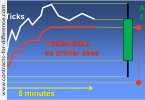There is a general move among CFD providers to offer more sophisticated order types that essentially represent a first step toward programmed trading. Traders cannot permanently watch the screen but most traders don’t want to miss opportunities. If done orders allow you to set an open order level be it limit or stop and if the trade is executed then a stop loss and take profit limit order can be automatically placed.
An ‘if done’ or ‘contingent order’, for example, is linked to an existing pending order — most commonly a limit or stop order to open a position. In a similar way to an OCO, an ‘if done’ order links two CFD orders together. The difference in this type of order is that once the first order is executed the second one is automatically entered into. The ‘if done’ order would lie dormant until the initial stop or limit order had been filled, at which point it would kick into life as a pending order awaiting execution.
An Example of an ‘If Done’ Order
Commonly an ‘if done’ order is used to set a limit entry and ‘if-done’ a stop-loss level. Let’s take an example -:
XYZ stock is trading at $19.00 and you want to buy if it goes down to $18.75, but you want to exit if the price continues to go down at $18.50. You can place an if done order: ‘Buy XYZ stock @ 18.75 limit; if done, sell @ $18.50 on stop’.
When you use a parent and contingent order, you are able to set up a whole trade with entry and exit conditions based on the market prices you decide. You are detailing two different orders, and then associating them via an if/then condition so that the second order is contingent on the first one having been fulfilled. This means the two orders can and will be executed consecutively, for instance if the second order is to sell a security at a certain price, the first order may have been to buy it in the first place. Using the parent and contingent order, you don’t have to be watching the market place all the time.
Now if you normally make your entry into the market while trading is open, and use a market order based on the price that you see, the parent and contingent order won’t matter much to you. But if you have a conditional entry, using either a limit or stop order, and won’t be around to see when it is triggered, the parent and contingent order may be just what you’re looking for.
An example will make it clearer. Suppose you want to go long in a financial instrument, but only if the price drops to a certain level that you find acceptable. You would enter a limit order for this, stating a limit that you’re prepared to pay, but you don’t know if or when this will be filled. Any time you enter a trade, you want to put a stop loss order in place to protect you from the downside of the price moving in the wrong direction. This may even be a trailing stop order, so that the level rises while the security is making money, but you automatically capture the profit if the price comes down by the amount you set on the trailing stop.
To use a parent and contingent order, your first order is a buy limit order to get you into the trade. The second order will not be active until the first order, called the parent, is filled. So when the price dips enough to trigger the buy limit order, you will be entered in the position and automatically the second order, called the contingent, will become active. You can specify whatever type of order you want as the contingent, and you might well make this a trailing stop order for the security.
The result of this is that you have entered the trade at the price you wanted, and if the price goes up as you expect then you will have a trailing stop in place to capture the profits when the price retraces from its rise. On the other hand, if the price continues falling after you get into the trade, the trailing stop will take you out before your losses are too large. Either way, the effect of the parent and contingent order is to automatically manage your trade in the way that you would have chosen if you had the time to watch it unfold.
Managing Risk with If Done Orders
Trailing stops can be combined with ‘if done’ orders as a way of managing risk and locking-in profits. The ‘if done’ order gets you into the trade at the price you want and then if it goes in the direction you expected, then a trailing stop will capture partial profit if the price changes direction. If the price moves in the opposite direction, the trailing stop will prevent your losses from becoming too large. The ‘if done’ order allows automatic management of trades that mirror your trade management if you were watching the price action unfold and can be utilized to wait for the market to come to you.







